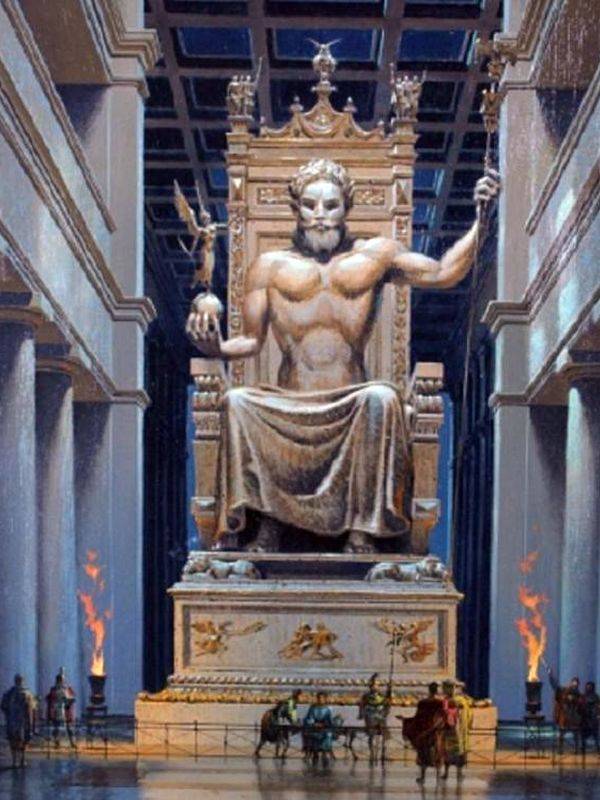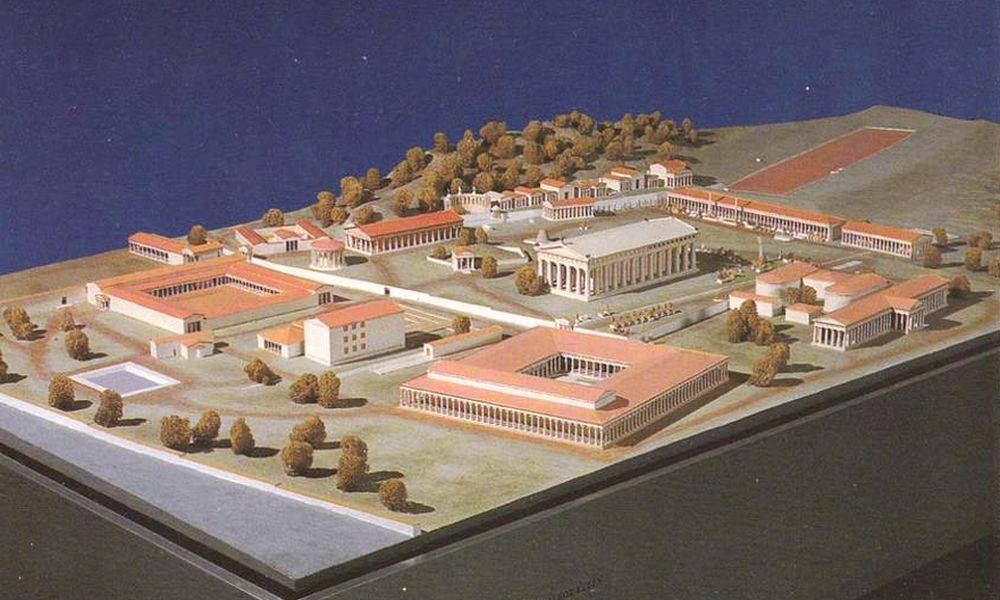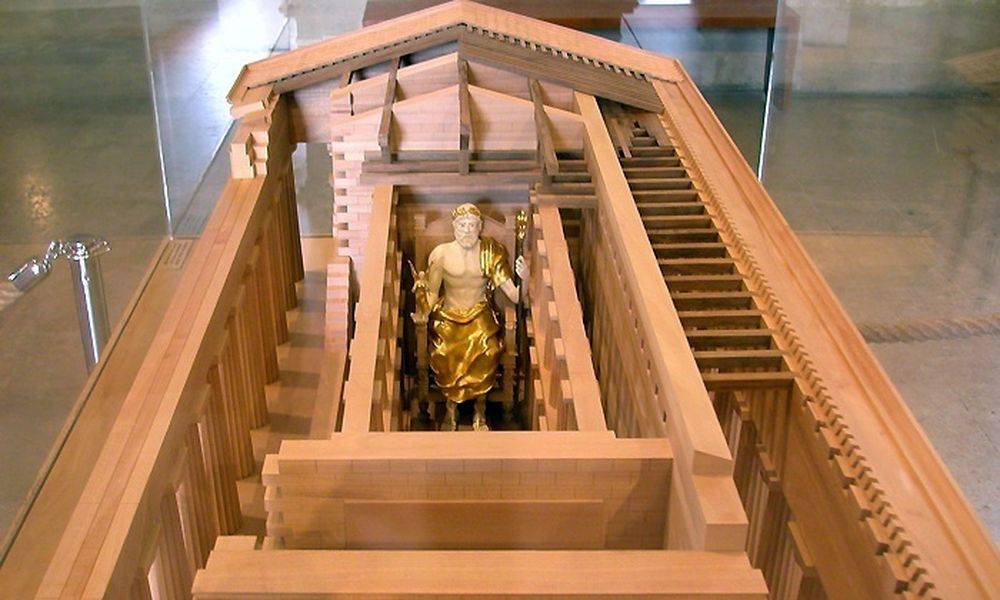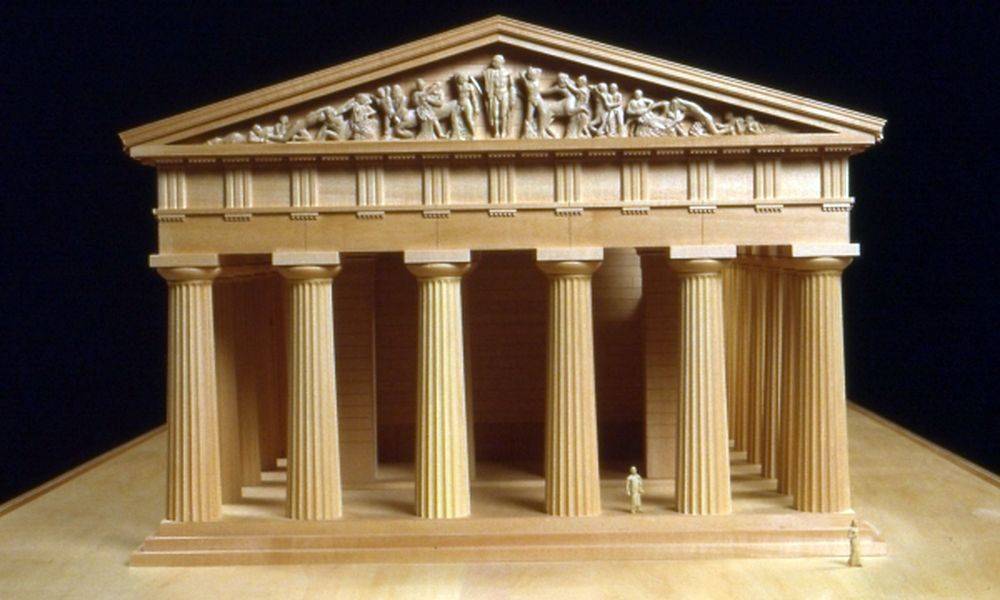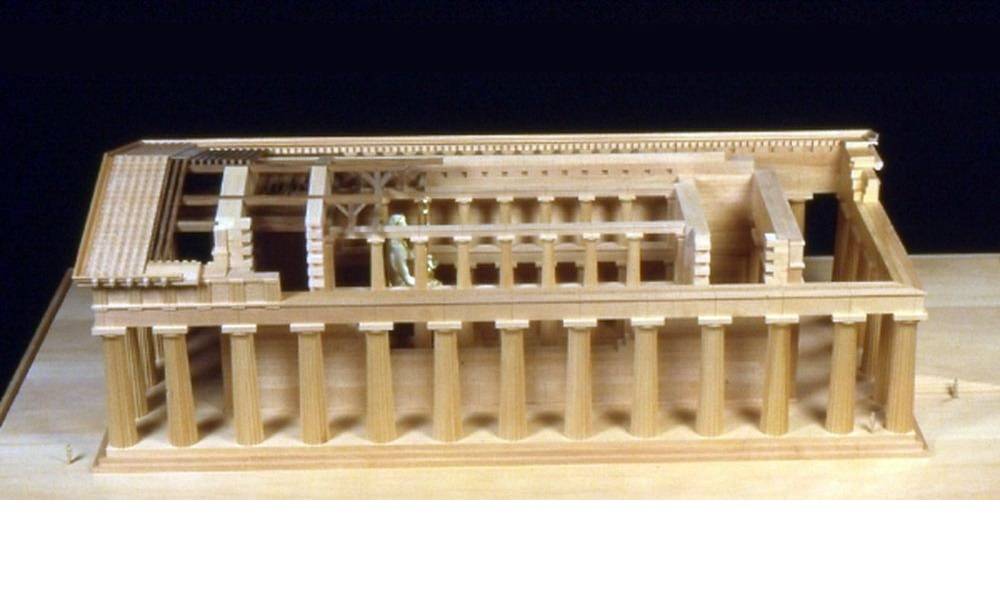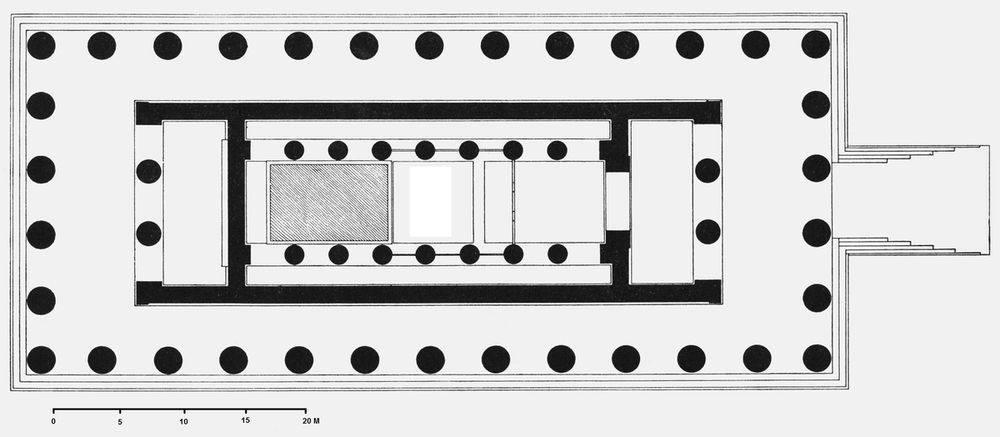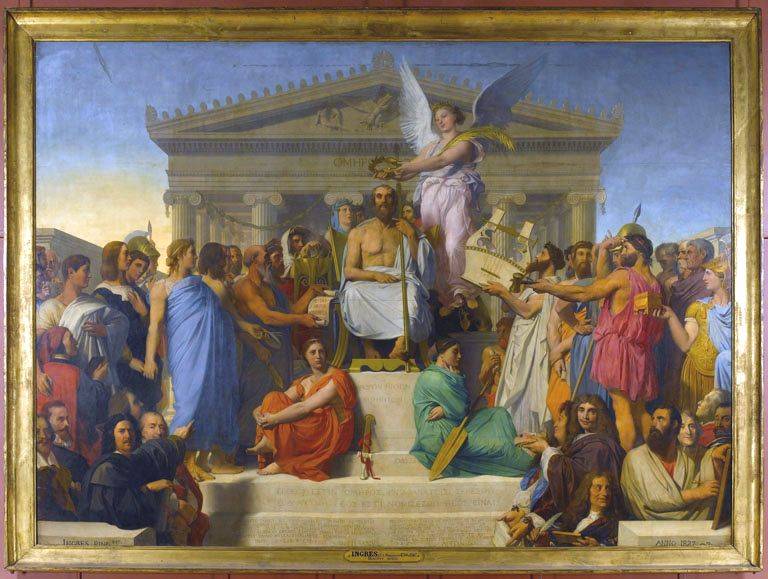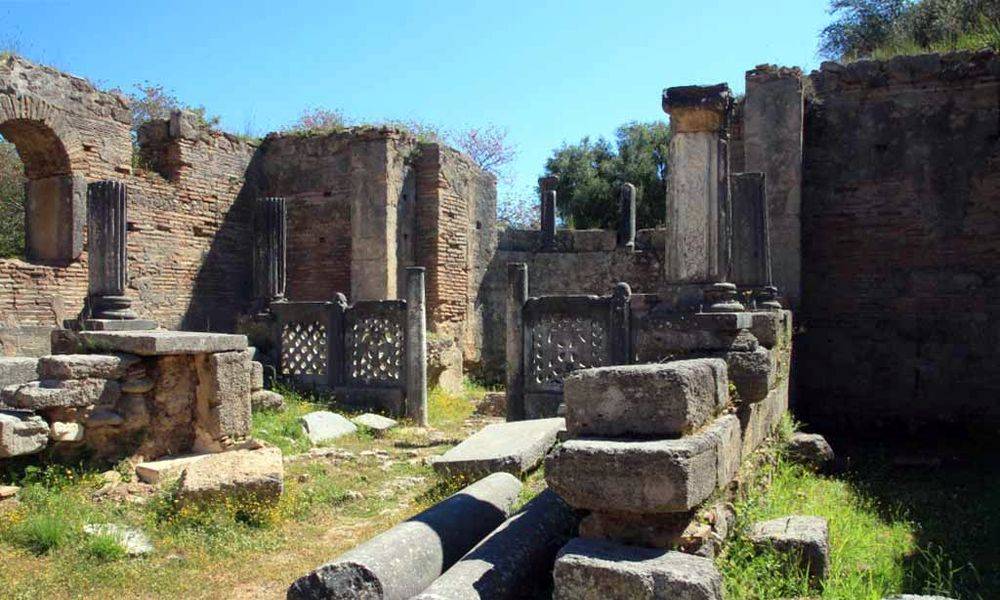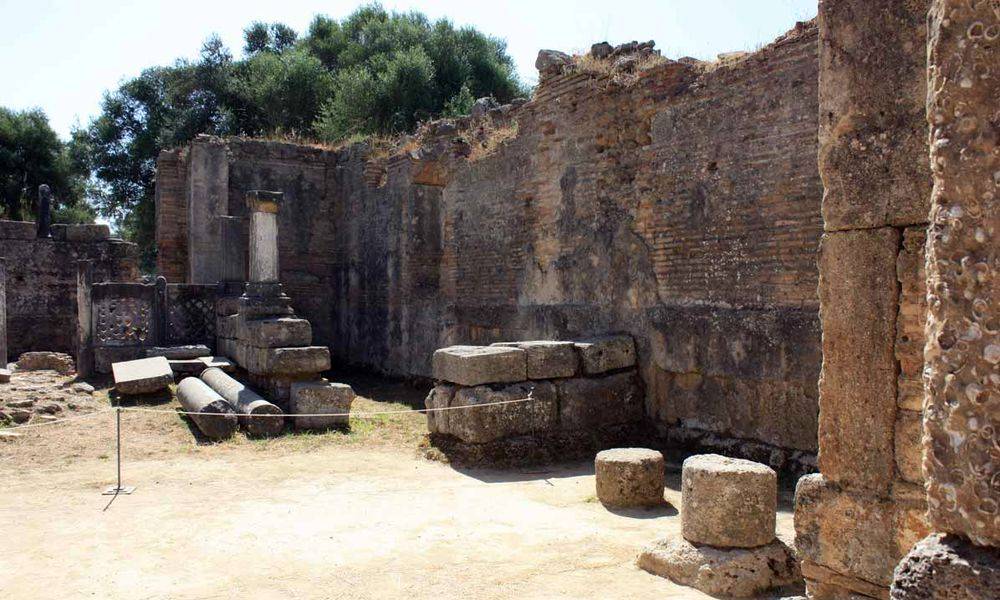The statue of Zeus is one of the seven wonders of the ancient world. It is a chryselephantine statue, which means it was made of ivory and gold. History has not left us any vestiges of this statue, it has been destroyed, and there are very few representations dating back to the time it existed, which makes it one of the marvels a little apart, for which doubts remain about the reality of its form, the position of Zeus, its attributes, and so on. Its history, however, is fairly well known. His builder is Phidias, an Athenian sculptor who did a similar work shortly before that of Olympia which serves us as a reference today, but this artist was known for other sculptures. He created the statue of Zeus in 436 BC.
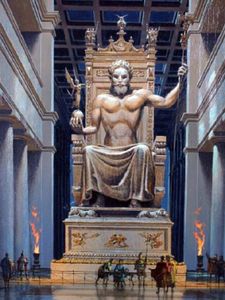
The statue of Zeus
Documentary sources
As said above, we have very few documentary sources about the statue of Zeus. One of the rare performances is on a coin of the time, an image far removed from reality. These are contemporary texts that speak the best of them, and fortunately the fact that Zeus is represented makes it possible to have information because the God of the Gods was often evoked, and by logic his statue was more than for the other gods. There is also another documentary source: The remains of the workshop of Phidias, the sculptor, who worked at Olympia in a very specific workshop in which the archaeologists found some remains of that time, informing us about the techniques used. But the harvest was meager, it must be said.
So little information on this statue, but since he had made other statues before, we know how Phidias worked and what he used as material.
The reasons for the construction of the statue
The city of Olympia, in the western part of the Peloponnese, was an important cultural center of ancient Greece, from the eighth century BC. It is home to the ancient Olympic Games, a sports competition of great renown whose modern versions always take place every 4 years. The city was placed under the protection of Zeus, the God of the Gods according to Greek mythology. It had a temple that was completely rebuilt in the 5th century. This new temple, very large, had to accommodate a gigantic statue.
It is therefore simply a religious belief that is at the origin of the construction of the statue of Zeus. It was a matter of honoring the patron of the city, quite simply, at a time when Olympia was gaining popularity throughout ancient Greece.
Its location
The statue of Zeus was in a temple dedicated to him (that is the least thing ...), in the city of Olympia. Olympia was a city of great importance in Antiquity, it existed from the protohistoric period and was only improved until the end of the Roman Empire. It was on the Peloponnese, to the west, near the coast. It was not, however, a coastal town, it was east of the Kladéos River, in the green valley of Alpheus to the southwest of Mount Kronion
It was in Olympia that the infrastructure of the Olympic Games was located. So the city was home to a stadium, a theater, many temples, but the most important of them was of course dedicated to the God of the Gods, Zeus. This temple stood out among the rest, it was the longest, the broadest, and the tallest of all. It was he who welcomed the statue of Zeus. This temple was in the center of Olympia, in an open area.
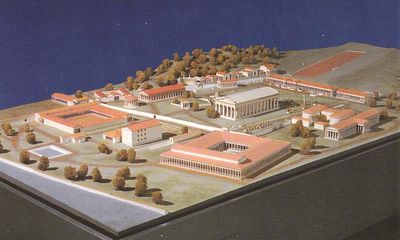
Model of Olympia
Learn more about the location of Olympia.
Successive temples
The archaic temple
The temple of Zeus in the sense that we hear it nowadays was not the first on this site. The history of Olympia begins as early as the 8th century BC with the first Olympic Games in 776 BC. During the 7th century a first temple was built to the south of Mount Kronios, it served as a cult center for the site. It was of Doric style, but its wooden columns were replaced by stone columns thereafter. It must be known that archaeologists have found in this archaic temple a head of the statue of Hera, who was the wife of Zeus and the goddess of marriage. This confirms this temple as being the first to be dedicated to Zeus on this site.
The Hellenistic Temple
In the 5th century BC the Eleans gained an important victory against Pisa. To celebrate this victory, they decide to build a new temple instead of the old one, it is to this one that one makes reference when one talks about the statue of Zeus. The architect was Elon's Libon who built it with the same Doric style as the previous one, but using different materials such as limestone covered with stucco. By using limestone and not marble it avoided all problems of supply (marble quarries are rare in Greece), transport (transport techniques not being as reliable as a few centuries later), and (the hardness of the stone is ideal for strength, but not for carving in regular blocks or for carving). An exception however: The roof cover which was well marble.
This temple was completed in -457. It measured 64.12 m by 27.68 and was the largest of all mainland Greece. It served for worship until 397 AD, when the Roman Emperor Theodosius promulgated the banning of polytheistic cult and banned the Games. In the 6th century AD it suffered the torments of an earthquake and was completely destroyed. Forgotten, the temple was buried by centuries of silt deposits.
The site will be discovered in the nineteenth century by Richard Chandler, who will carry out 6 years of excavations. The site will be excavated again from 1936 to 1966.
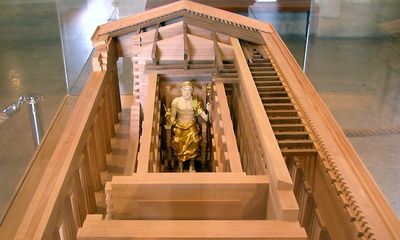
Model in the Louvre
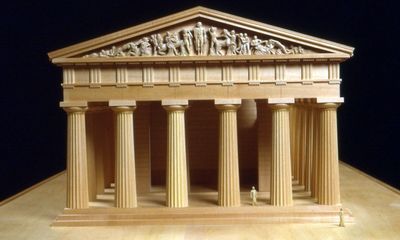
Model in the Louvre
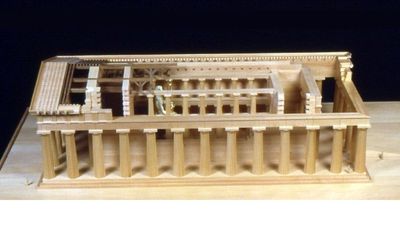
Model without the roof
Description of the Hellenistic Temple
The temple of Zeus in Olympia was classical according to the criteria of ancient Greek architecture. It was rectangular in shape and had a row of columns 10m high which completely surrounded it. It had an entrance to the east and its roof was two slopes, it rose up to 22m in height, forming a gable on the front and back facade. The two pediments were very decorated. The one in front represented Zeus in the center, surrounded by scenes of preparations for the chariot race, which, according to the legend, opposed Enenos and Pelops for the hand of Hippodamia. The one in the back represents the battle of the Centaurs against the Lapiths. Apollo sits in the middle of the western pediment.
When the sun rose, he entered the vestibule, the room used as an entrance, and according to the seasons it even reached the Naos (the equivalent of the nave of a church, the body of the building). equipped with two rows of columns to hold the wooden frame. Inwardly there were two levels in the temple, a spiral staircase rising to the upper floor on the wooden galleries.
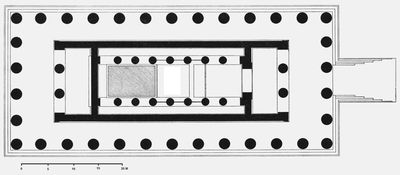
Plan of the temple of Zeus
In the back of the Naos was the opisthodome, a room behind the sanctuary and containing the offerings. Forbidden to the public, this piece was richly decorated with scenes involving Herakles, decorations nowadays visible in the Louvre, Paris.
The floor of the temple was made of large slabs of limestone covered with marble slabs. The Naos contained the statue of Zeus, which was chosen as the marvel of the World.
Description of the statue of Zeus
It is difficult to describe in detail the statue of Zeus of Olympia because we have no vestige of it, it burned early in history and there are no faithful representations of this work today, on the contrary, for example, of the "lighthouse of Alexandria, for which there are painted or mosaic images." For the statue, nothing at all, except a coin whose fidelity of reproduction leaves something to be desired.
However, the testimony of Pausanias, who described it during the first century of his life, serves as our guide. The statue was 13 meters high, it was larger than that of Athena, which Phidias had made shortly before at Athens. The visible parts of the body were of ivory to simulate the whiteness of the little while the clothes, the beard and the hair were of gold. The hair received an olive crown made of silver. If the images that are proposed today show the statue holding a Victory in his right hand and a scepter in his left, it seems that it is not only a modern vision but a fact. The garment, a cloak, was richly ornamented with brightly colored designs.
Symbols of the statue of Zeus
Unlike other older Zeus representations, Phidias chose to create a calm Zeus, with contained force. Previously it was frequent that he was represented in fury, holding in his hand the flashes. The idea of the artist was to succeed in showing a powerful but reigning God in the calm, assured of his victory. This is the reason for the presence of certain symbols found there:
- The victory held in his right hand,
- The crown of olive tree, symbol of power
The message that Phidias passes and that Zeus watches over the city in a benevolent way and more with fear or threat, as in previous centuries. This can be seen as a step in the Greek relationship with their religion, a stage which would correspond to a period of development of the Greek civilization which no longer needed to live in fear in order to progress.
The construction of the statue
The decision to make a large statue inside the temple of Zeus was taken some twenty years after the completion of the construction of the temple.
Manufacturing method
Of course it is difficult to know how Phidias worked when he executed this statue. Moreover, the specialists are not even sure of the exact dates during which he was in Olympus, but we know the dates of work in Athens, for the realization of the statue ordered by Pericles: 447 to 438, or 9 years. It seems therefore logical that the work in Olympe lasted for a similar time.
What we know with certainty is that he never worked alone, he was always a team leader who commanded the craftsmen of various trades. This was corroborated by the archaeological research done in his workshop, a workshop in which we found tools of different workers. It was in this workshop, near the temple, that Phidias had the drawings used as a project. On the basis of these drawings he had cabinet-makers build the various parts of the statue, which he mounted directly into the temple. Then he carved in ivory thin slices which he carved and whose role was to cover the statue where the skin was. If the statue of Athena had only the face of discovery, that of Zeus had all the torso more, the work was therefore of a whole other magnitude. So how to make large surface in ivory, a rather rigid material, with narrow leaves?
The answer seems to be that an elephant defense is composed of a winding. By cutting it precisely it is possible to unroll leaves that are then larger than a slice carved in its heart. Then the leaves had to be softened that they would lose their rigidity, which was done by an unknown process. It is known that ivory can be manually worked once it has been relaxed, but the techniques of easing diverge from one civilization to another and from one period to another, and we do not know what was being done in Olympe during the 'Antiquity. Finally when ready the ivory plates were fixed, probably to glue, then polished to make them shine and mask the joints.
The clothes were made of gold or silver in the form of thin leaves that were adjusted to the contours of the wood. The quality of the work, it seems, was so perfect that the joints between the plates could not be seen, and so the statue truly appeared to be made of ivory and gold.
The throne was not covered with ivory or gold, it was simply painted. Although Phidias had a good knowledge of painting, he had this work done by a member of his family, Panaenos, who chose to reproduce scenes from mythology. It seems that these scenes had a great success.
Finally we know that the glass was used on the statue, but the specialists do not all agree on its role. Glass was at the time an expensive material that came from the East of the Mediterranean.
Origin of materials
The statue of Zeus was made of wood, which is why it completely disappeared these days, burned in a fire. It is especially his decorations that are impressive. The materials used are gold, ivory, bronze, glass and various other materials.
The wood was cypress and cedar (after Dion Chrysostom), woods that were reputed to be imputable at the time.
The origin of gold is completely unknown. We know that there were gold mines in Macedonia, a territory not so far from the Peloponnese, but it could also come from other sources, such as the one in Africa, for example. For the ivory a text of Pausanias enlightens us a little more. He writes this on this subject:
Besides, nothing in my opinion better indicates the piety of the Greeks and their profusion, where it is a matter of decorating the temples, and the prodigious quantity of ivory which they have drawn from the Indies and Ethiopia, the statues of their gods.
How much did the statue of Zeus cost?
It is a very difficult question to know the cost of the statue of Zeus. In fact no document speaks of it, and there is no archaeological source to deduce it. On the other hand, it is possible to work by cross-checking and to have a vague idea.
First of all, the statue was made of wood covered with gold, ivory and silver, three precious materials. Since it was 13m high, one can imagine the impressive amount of metal that it took, the same for ivory. Some witnesses or others who described the statue say that the expenses were sumptuous, but without giving details. Moreover, the cost of transport was added because the ivory came from Egypt, so the journey was very long and costly, especially for such a load.
Apart from the materials it is necessary to know that the statue was also expensive in wages, since several workers worked there for years, the salary of the main sculptor, Phidias, being one of the most significant. Besides, the latter will be accused of having diverted some of the gold and ivory for his personal gain, which will, it seems, lead to his disgrace.
So we see, impossible to have details on the cost of the statue of Zeus.
Its history
The history of the statue of Zeus is quite simple, it has not undergone important changes. Built around 436 BC, it was installed in the temple of Zeus in Olympia and remained there until 395 AD. It was a time when the emperors began to take an interest in the pagan works which had been abandoned at the time of the adoption of Christianity. In 382 an edict authorized the temple to be opened to allow the population to contemplate the ancient works which have a great artistic value, but it was of short duration because in 392 a decree orders that one closes the pagan temples, and the Olympic Games are prohibited. It was at this time that it was decided to transport the statue of Zeus in the capital of the Empire, Constantinople (currently Istanbul, Turkey). This was done in 395 AD, the statue was stored at the Lauseion, a sort of museum ancestor. Unfortunately in 475 a fire ravaged La Luseion and the work of Phidias was lost forever.
The manufacturer, Phidias
Phidias was a Greek sculptor of the 5th century BC who is basically known for having built one of the wonders of the World, the statue of Zeus. His life is little known, history has not bequeathed enough materials to reconstitute it exactly. However, the people who speak of it in documents written later in his day (Pliny the Elder, Cicero, Strabo, Plutarch) give information which enables us to trace certain important events in his life.
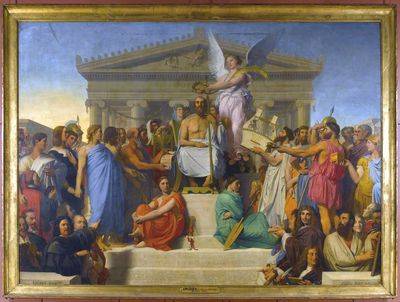
The Apotheosis of Homer
Phidias was born about 490 BC in Athens, he was the son of Charmides, a name often attached to his to designate him. Formed in sculpture by Ageladas, a master who worked several times for the decoration of the sanctuary of Olympia, he obtained at the age of 20 years an exceptional mastery of his art. At that time he made a statue of Athena 8m high in wood covered with gold whose hands and feet were in marble. This statue was an order of the city of Plataea.
Between 464 and 450 BC, he made two bronze statues which were placed on the Acropolis, a statue of 9m high called Athena Promachos, of which Pausanias says, "The navigators on Cape Sounion could distinguish the point of lance and the helmet egret ", and the Athéna Lemnia. At the age of 43 (447 BC) Pericles confided to him the decoration of the Parthenon, the pediments and the execution of the chryshephantine statue of the naos of Athena Parthenos, which measured 11.5 m high. Phidias worked at this statue from 447 to 438, nearly nine years. It is this technique of assembling gold leaves and ivory pieces to make colossal statues that will make Phidias a sculptor admired by all.
Alas for his friendship with Pericles, he was accused in 433 of having diverted some of the gold and ivory destined for the statue. He is condemned and flees to Olympia where he is proposed the construction of the chryséléphantine statue of Zeus, a site he accepts. It is important at this stage in its history to indicate that the chronological order between the realization of the statue of Athena and that of Zeus is not fixed, the specialists contradicting sometimes. As a result, Phidias did not know exactly how long Phidias worked at Olympia. A serious hypothesis indicates that Phidias would never have fled from Athens, but would have been consecrated at the inauguration of the Parthenon, which enabled him to obtain various proposals, including those of the Eleans at Olympia. Another element is that Phidias would have made the statue after that of Athena: On the statue of Zeus there is a personage who is, according to Pausanias, Pantarkes. Pantarkes won the wrestling contest during the 86th Olympiad "(436 BC).
Finally to finish with Phidias it is necessary to know that its workshop was discovered, archaeologically speaking, on the site of Olympia. Objects have been found but do not yet specify the dates on which they were used. This painting was originally commissioned for a ceiling of the Charles X Museum (1827). This painting was initially commissioned for a ceiling of the Charles X Museum It shows Homer deified surrounded by artists of Greek antiquity.
Learn more about Phidias.
Archéological site
The site of Olympia is rich in archaeological remains, but unfortunately the statue of Zeus having been moved before disappearing one can hardly expect to find information on what it was there. However, in 1958 the excavations undertaken outside the sanctuary allowed the updating of the workshop of Phidias. There are characteristic carving tools.
This site, of which pictures are given below, is to the west of the temple. It also contained remnants of glass-making activity, as well as remnants of gold, ivory, semi-precision stones, bronze, ebony and amber pieces, plaster, and a statue on which one reads his belonging to Phidias.
The archaeologists made a comparison of the dimensions of the workshop and the naos of the temple (the sanctuary), and since it is of the same size they can conclude that, hypothetically but probably, the statue was made piecemeal in the workshop , each piece being transported in the sanctuary as the work progresses.
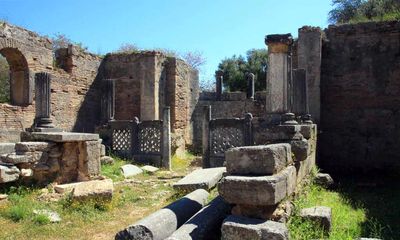
Workshop of Phidias
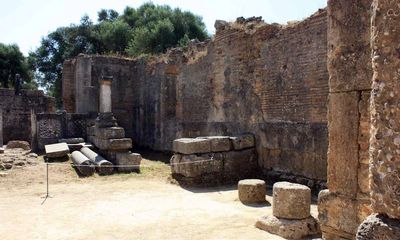
Workshop of Phidias
See also:





